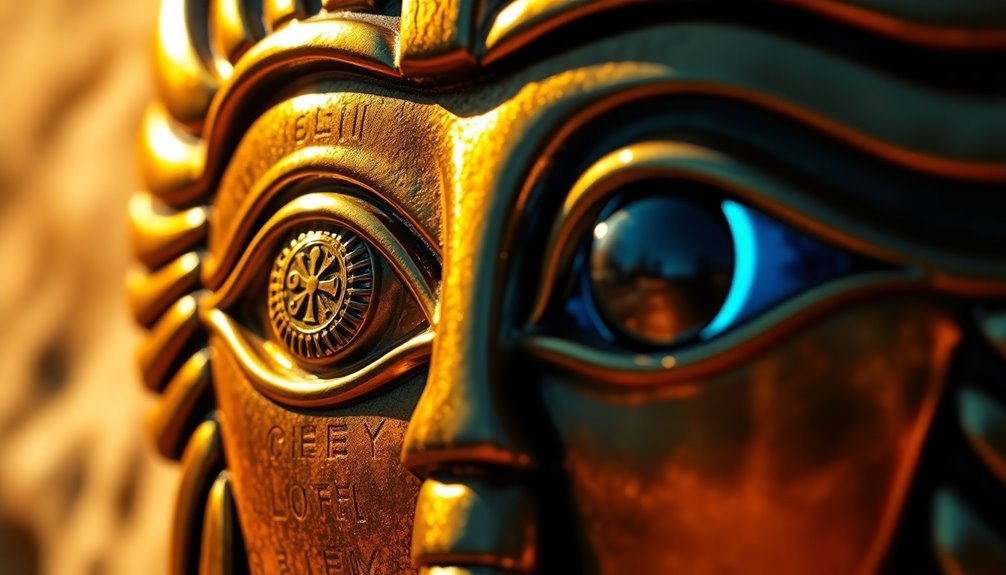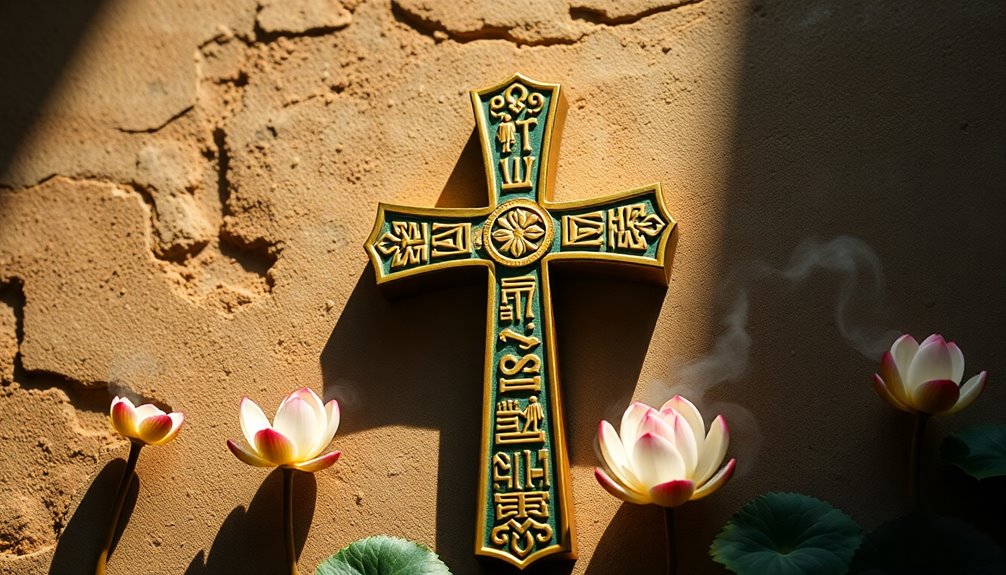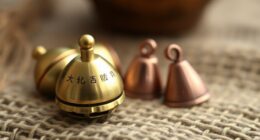The direction of the Eye of Horus—left or right—deeply influences its meaning. If you choose the left eye, you embrace healing and protection, linked to nurturing and new beginnings. Opting for the right eye symbolizes power and strength, connecting you to completion and triumph. This duality represents a balance essential in ancient Egyptian beliefs, highlighting the interconnectedness of life. Whether you wear it as jewelry, a tattoo, or a talisman, the chosen eye reflects your personal journey. Understanding these distinctions can enrich your experience; stick around to uncover more about its enchanting symbolism and applications.
Key Takeaways
- The left Eye of Horus symbolizes healing, protection, and new beginnings, while the right eye represents power, strength, and completion.
- Direction determines the specific attributes each eye embodies, influencing personal interpretations and uses in jewelry and spiritual practices.
- The left eye is associated with Hathor, while the right eye is linked to Ra, highlighting their distinct mythological connections.
- Variations in artistic representations can lead to confusion about their meanings, emphasizing the importance of context in understanding the Eye of Horus.
- Choosing an eye direction in modern applications can enhance personal empowerment, protection, and alignment with individual goals and aspirations.
Symbolism of the Eye of Horus
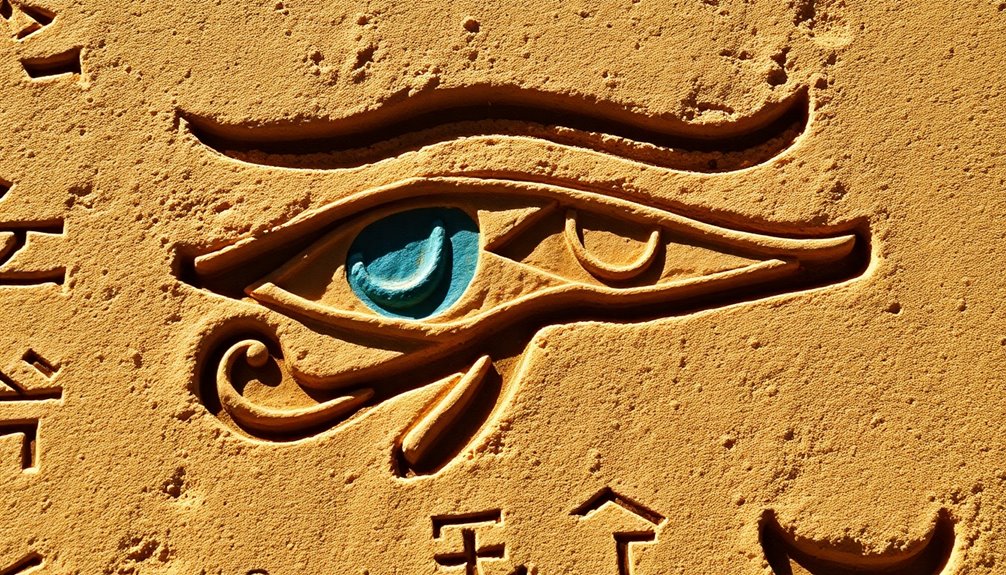
The Eye of Horus, often viewed as a powerful symbol, represents protection, healing, and divine royal authority in ancient Egyptian mythology. When you look closely, you'll find that the left eye of Horus holds a special significance. This eye is associated with healing and protection, embodying the nurturing aspects of the Horus myth. It stands in contrast to the right eye, which symbolizes power and strength, highlighting how these elements work together to create balance.
This stylized human eye, known as the Eye of Horus symbol, feeds into themes of wholeness and resilience. You'll often spot it in ancient Egyptian artifacts and jewelry, serving as a protective amulet designed to ward off evil. Its presence in funerary practices emphasizes its importance in safeguarding the deceased on their journey to the afterlife.
Additionally, the Eye of Horus connects deeply to struggles and recoveries, particularly through the tales of Horus's conflict with Seth. The left eye's restoration by Hathor symbolizes hope and healing amid adversity, making it a potent reminder of your own strength during challenging times.
Mythological Origins of Horus
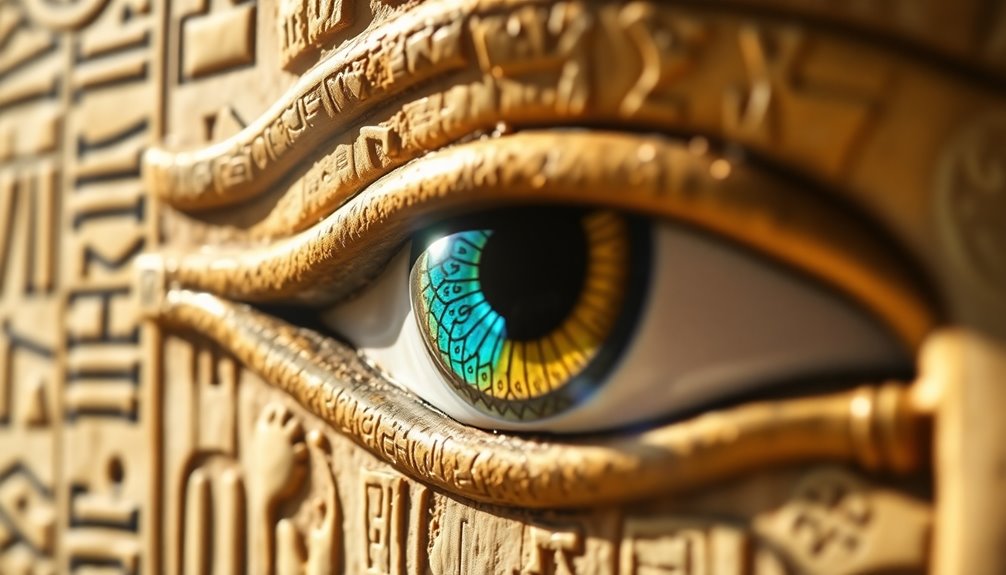
Horus's story is steeped in a fierce conflict with Seth, the embodiment of chaos, who murdered his father, Osiris.
This battle not only defines Horus's quest for kingship but also leads to the legendary restoration of his left eye by Thoth, a god of wisdom.
Understanding these origins reveals the deeper significance of the Eye of Horus in ancient mythology.
Horus and Seth Conflict
In ancient Egyptian mythology, the conflict between Horus and Seth serves as a vivid representation of the struggle between order and chaos. Horus, the falcon-headed god, embodies the principles of harmony and rightful rule, while Seth, known for his chaotic nature, represents violence and disorder. Their battles are more than mere skirmishes; they symbolize the eternal struggle for balance in the universe.
During one of their fierce confrontations, Seth mutilated Horus's left eye, a significant act that showcases Seth's destructive tendencies. This loss signifies not just physical defeat but also the trials of loss and resurrection that are central to Horus's narrative.
However, the story doesn't end in despair. The goddess Hathor later restored Horus's eye, symbolizing healing and the return to wholeness.
The restoration holds deeper meaning as it emphasizes the triumph of good over evil. Thoth's role in this revival further reinforces the protective qualities associated with the Eye of Horus.
Through this myth, you can see how the conflict between Horus and Seth shapes the themes of divine right, resilience, and the perpetual battle for order in the cosmos.
Eye Restoration by Thoth
While battling Seth, Horus faced a devastating loss when his left eye was mutilated, a moment that marked a turning point in his mythological narrative. This injury symbolized not just a physical loss, but also the chaos that Seth represented. In the aftermath, divine intervention became vital. Thoth, the god of wisdom and writing, stepped in to restore Horus's eye, embodying healing and the return to wholeness.
Thoth's role in this restoration highlights the ancient Egyptians' belief in the power of gods to mend what's broken. The process of restoring the eye mirrors the lunar phases, emphasizing renewal and the cyclical nature of life. Just as the moon waxes and wanes, Horus's eye was reborn, symbolizing resilience in the face of adversity.
Once restored, the Eye of Horus became a powerful emblem of protection and health, often crafted into amulets to ward off evil and misfortune. This transformation not only reflects Horus's triumph over chaos but also signifies the importance of recovery and balance in life, showcasing how Thoth's wisdom played an essential role in the mythology surrounding Horus.
Cultural Significance and Usage

Recognized as a powerful emblem in ancient Egyptian culture, the Eye of Horus symbolizes protection and healing. This iconic symbol was often used in funerary practices, where it adorned tomb decorations and amulets. People believed that incorporating the Eye of Horus would safeguard the deceased in the afterlife and provide spiritual protection.
The left eye, representing Horus, is linked to rejuvenation and new beginnings, while the right eye, associated with Hathor, signifies strength and completion.
Beyond its origins, the Eye of Horus has transcended ancient Egypt, influencing neighboring cultures. You might find it featured in various forms, like jewelry and tattoos, as a representation of good luck and protection.
Its versatility makes it a popular choice for those seeking spiritual security or a reminder of resilience in their daily lives. The symbol's historical significance resonates with many, serving as a connection to ancient traditions and beliefs.
Whether you wear it or display it, the Eye of Horus can inspire a sense of safety and well-being, enriching your personal journey with its profound cultural heritage.
Distinctions Between Left and Right

Understanding the distinctions between the left and right eyes of Horus reveals the rich symbolism embedded in ancient Egyptian beliefs.
The left eye is a powerful symbol of healing, protection, and new beginnings. It's associated with the sun's rising and the goddess Hathor, reflecting renewal and liveliness. This connection emphasizes the importance of growth and rejuvenation in life.
On the other hand, the right eye represents power, strength, and completion. Linked to the sun's setting and the qualities of the god Ra, it embodies the culmination of efforts and achievements.
Both eyes convey distinct meanings, yet they're complementary, illustrating the balance of duality in ancient Egyptian belief systems.
In art, the orientation of the Eye of Horus can vary, causing confusion about which eye is "true." The specific meanings often depend on the context in which you encounter them.
Ultimately, the left and right eyes symbolize different aspects of life and the cosmos, reflecting the interconnectedness of all things in ancient Egyptian mythology. Recognizing these distinctions allows you to appreciate the depth of their cultural significance.
Healing and Protection Aspects

The healing and protection aspects of the Eye of Horus are deeply rooted in ancient Egyptian beliefs, particularly tied to the Left Eye. This eye symbolizes the moon's restorative powers, representing renewal and the essence of healing.
Ancient Egyptians wore amulets featuring the Left Eye to safeguard against ailments and promote good health. These amulets reflected the significance of the Eye in medical texts, highlighting its protective qualities.
You'll find that the healing properties of the Left Eye were believed to provide spiritual protection against malevolent forces, enhancing your overall well-being. In this way, it acted as a shield, allowing individuals to thrive while repelling negativity.
While the Right Eye of Horus represents power and strength, it completes the vision of health and protection, emphasizing the need for both spiritual and physical wellness.
Together, these eyes embody a holistic approach to healing, showcasing the interconnectedness of the body and spirit.
Modern Interpretations and Applications
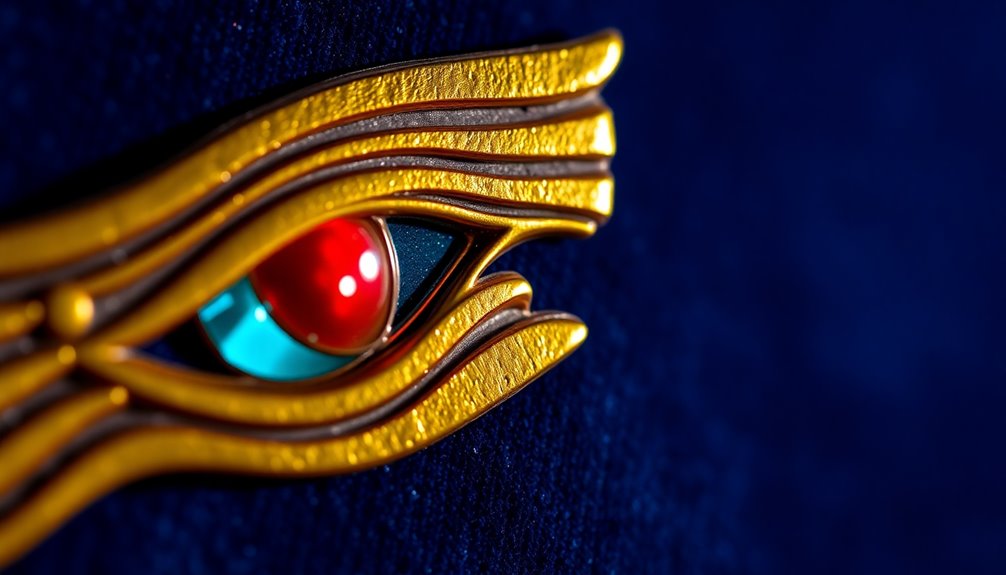
In today's world, the Eye of Horus has taken on new meanings and applications, resonating with those seeking protection, empowerment, or spiritual insight. This ancient symbol is now prevalent in modern jewelry, allowing you to personalize its direction for your unique intentions.
Here are some ways you might see the Eye of Horus interpreted today:
- Jewelry Design: Many modern jewelry pieces feature the Eye of Horus, with personalized directional choices enhancing protection or empowerment.
- Spiritual Practices: The left eye is linked to healing and protection, while the right eye symbolizes power and strength, letting you choose based on your goals.
- Amulets: Contemporary amulets using the Eye of Horus aim to deflect negative energy and attract good luck, influenced by the eye's orientation.
- Tattoo Culture: The Eye of Horus remains a popular tattoo motif, representing personal protection and spiritual insight, with individuals selecting the direction based on their beliefs.
- The Eye of Horus is often associated with Tiki Figures, representing protection and guidance in various cultures.
Practical Uses in Daily Life
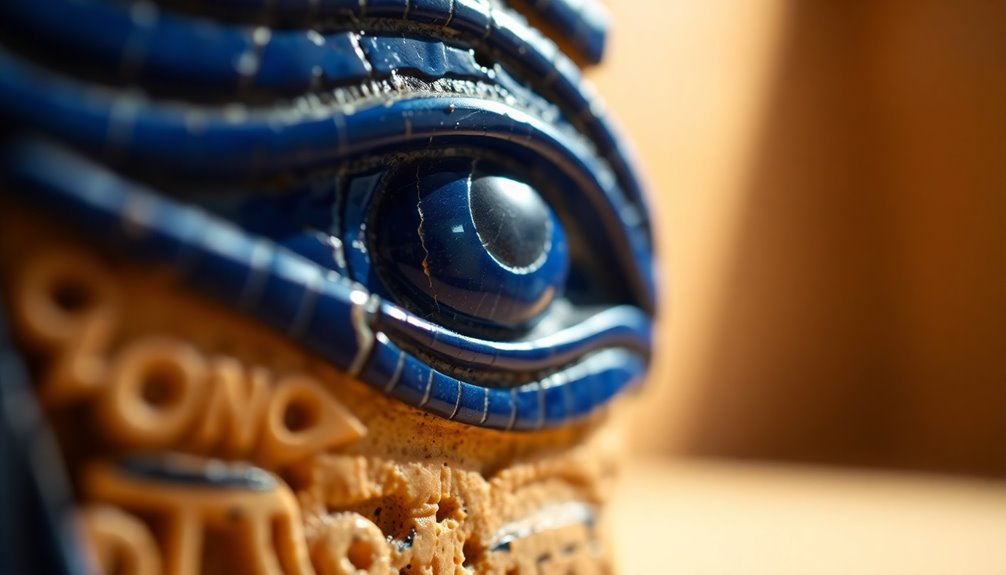
Incorporating the Eye of Horus into your daily life can enhance your sense of protection and well-being. You can wear it as jewelry, like necklaces or red string bracelets, to deflect negative energy. Each piece can be personalized based on the eye's direction, offering unique benefits. The left eye symbolizes healing, while the right eye represents strength.
Here's a quick look at some practical uses:
| Item Type | Purpose |
|---|---|
| Amulets/Jewelry | Personal protection and good fortune |
| Keychains | Portable talismans for daily use |
| Red String Bracelets | Deflects negativity and promotes luck |
Exploration of Ancient Contexts

Exploring the ancient contexts of the Eye of Horus reveals its rich symbolism and varied interpretations. This powerful symbol, known as the Wadjet, can be depicted in both left and right orientations, each carrying unique meanings tied to different deities and concepts.
Here are four key insights about the Eye of Horus in ancient Egyptian contexts:
- Left Eye: Represents the god Horus, associated with healing, protection, and the moon, symbolizing renewal and new beginnings.
- Right Eye: Linked to Hathor, it signifies strength, power, and the sun, representing completion and triumph over chaos.
- Directionality in Egyptian Texts: The portrayal of the Eye varies based on context, narrative, and associated deities, leading to debates about its "true" meaning.
- Cultural Artifacts: Specific interpretations of the Eye's direction influence its use in amulets and artifacts, highlighting the importance of context in ancient Egyptian symbolism.
Frequently Asked Questions
What Is the Difference Between the Left and Right Eye of Horus?
The left and right Eye of Horus represent distinct aspects of ancient Egyptian mythology.
When you look at the left eye, you're seeing symbols of healing, protection, and new beginnings, linked to the moon.
In contrast, the right eye embodies power and strength, associated with the sun and completion.
Both eyes reflect duality and balance, offering insights into the ancient Egyptians' understanding of life, death, and the universe's cyclical nature.
Is the Eye of Ra Left or Right?
It's funny how you'd think the Eye of Ra would be less intense, but it's actually tied to the right eye of Horus.
This eye stands for power and the fierce energy of the sun, showcasing strength and aggression. While the left eye symbolizes healing and protection, the right eye's connection to Ra emphasizes its role in conquering chaos.
What Are the Sides of the Eye of Horus?
The Eye of Horus has two sides, each carrying distinct meanings. The left eye symbolizes healing and protection, often associated with the rising sun and new beginnings.
In contrast, the right eye represents power and strength, linked to the setting sun and completion.
When you explore these interpretations, you'll see how each orientation reflects different aspects of life, showcasing the balance between healing and strength in ancient Egyptian beliefs.
What Does the Bible Say About the Eye of Horus?
The Bible doesn't mention the Eye of Horus directly, but you can find parallels in themes of protection and divine oversight.
When you explore ancient symbols, consider how they reflect spiritual insight, much like biblical ideas about sight.
Though the Eye of Horus isn't a biblical symbol, its meaning can resonate with the biblical motif of God's watchful eye, highlighting the cultural exchanges of the ancient Near East.
Conclusion
In exploring the Eye of Horus, you've uncovered its rich symbolism and dual meanings. Did you know that over 80% of ancient Egyptians believed in the protective powers of this emblem? Whether you're drawn to its left or right depiction, both carry significant weight in healing and safeguarding. So, as you navigate modern interpretations, remember the ancient wisdom behind this symbol and how it can influence your daily life in profound ways.
